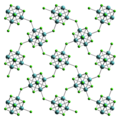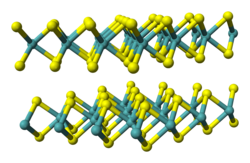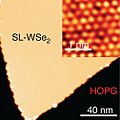Search results
Appearance
There is a page named "Tungsten(IV) iodide" on Wikipedia
- Tungsten(IV) iodide is a binary inorganic compound of tungsten metal and iodine with the chemical formula WI4. Reaction of tungsten(VI) chloride with...4 KB (293 words) - 17:15, 27 August 2024
- Tungsten(II) iodide is an iodide of tungsten, with the chemical formula [W6I8]I4, or abbreviated as WI2. Tungsten diiodide can obtained from the decomposition...3 KB (246 words) - 04:13, 30 November 2023
- Tungsten(III) iodide or tungsten triiodide is a chemical compound of tungsten and iodine with the formula WI3. Tungsten(III) iodide can be prepared by...3 KB (190 words) - 12:36, 16 October 2023
- Tungsten disulfide is an inorganic chemical compound composed of tungsten and sulfur with the chemical formula WS2. This compound is part of the group...22 KB (1,865 words) - 19:44, 18 March 2025
- 15513–69–6 WI4 tungsten(IV) iodide 14055–84–6 WOBr3 tungsten(V) oxytribromide 20213–56–3 WOBr4 tungsten(VI) oxytetrabromide 13520–77–9 WOCl3 tungsten(V) oxytrichloride...139 KB (120 words) - 18:51, 26 February 2025
- Tungsten diselenide is an inorganic compound with the formula WSe2. The compound adopts a hexagonal crystalline structure similar to molybdenum disulfide...14 KB (1,413 words) - 21:57, 12 March 2025
- Iodine (section Hydrogen iodide)iodide. For example, molybdenum(IV) oxide reacts with aluminium(III) iodide at 230 °C to give molybdenum(II) iodide. An example involving halogen exchange...104 KB (11,606 words) - 18:55, 21 March 2025
- 13766-47-7 WF5 tungsten(V) fluoride 19357-83-6 WF6 tungsten(VI) fluoride 7783-82-6 WI2 tungsten(II) iodide 13470-17-2 WI4 tungsten(IV) iodide 14055-84-6 WOBr3...183 KB (107 words) - 00:11, 18 March 2025
- Tungsten tetrafluoride is an inorganic compound with the formula WF4. This little studied solid has been invoked, together with tungsten pentafluoride...4 KB (223 words) - 22:19, 29 October 2024
- Uranium(V) iodide)about 70% higher than that of lead and slightly lower than that of gold or tungsten. It occurs naturally in low concentrations of a few parts per million in...110 KB (12,428 words) - 23:56, 13 February 2025the compound's diamagnetism. Its structure is very similar to that of tungsten(IV) chloride. Other coordination complexes with the formula NbCl4L2, such...5 KB (479 words) - 08:41, 27 March 2025
- Iodine compounds (section Hydrogen iodide)iodide. For example, molybdenum(IV) oxide reacts with aluminium(III) iodide at 230 °C to give molybdenum(II) iodide. An example involving halogen exchange...30 KB (3,560 words) - 17:50, 4 February 2025
- californium(III) iodide CfI3 lemon yellow +3 californium(III) polyborate Cf[B6O8(OH)5] pale green +4 californium(IV) oxide CfO2 black brown +4 californium(IV) fluoride...43 KB (4,620 words) - 09:29, 29 January 2025
- readily hydrolyzes to release HCl. Molybdenum(IV) chloride Molybdenum(VI) chloride Molybdenum(V) fluoride Tungsten(V) chloride Holleman, A. F.; Wiberg, E. (2001)...8 KB (597 words) - 09:14, 28 February 2025
- 715 °C. The fluoride is isotypic to LaF3 (space group P63/mmc) and the iodide to BiI3 (space group R3). The bromide is an exception with the orthorhombic...77 KB (9,374 words) - 03:02, 27 March 2025
- with iodine at temperatures of 500 °C (900 °F), forming hafnium(IV) iodide; at a tungsten filament of 1,700 °C (3,100 °F) the reverse reaction happens preferentially...47 KB (5,644 words) - 12:29, 6 March 2025
- Tungsten hexabromide, also known as tungsten(VI) bromide, is a chemical compound of tungsten and bromine with the formula WBr6. It is an air-sensitive...7 KB (441 words) - 11:23, 1 March 2024
- intended tungsten hexafluoride. MoF6 can be removed by reduction of a WF6-MoF6 mixture with any of a number of elements including hydrogen iodide at moderately...5 KB (455 words) - 18:20, 2 February 2025
- Tungsten oxytetrafluoride is an inorganic compound with the formula WOF4. It is a colorless diamagnetic solid. The compound is one of many oxides of tungsten...7 KB (582 words) - 11:50, 3 July 2024
- in potassium chloride solution renders molybdenum, niobium, ruthenium, tungsten, and vanadium passive (W. Muthmann and F. Frauenberger, Sitz. Bayer. Akad
- one—the precipitate. In the solution, there exists both lead and iodide ions. Because lead iodide is insoluble, they spontaneously crystallise and form the precipitate











